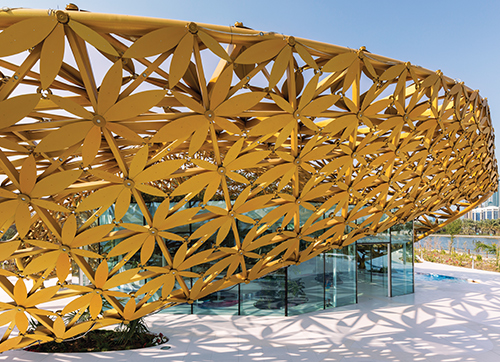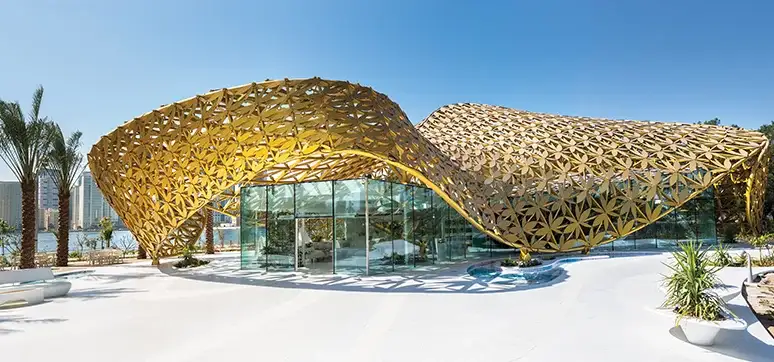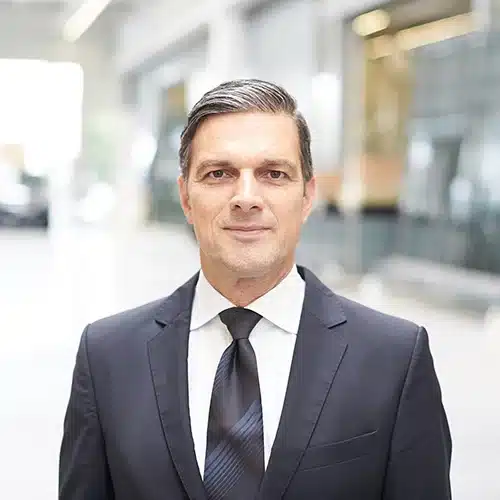What is your idea for the façades of the future? What features would you like to see in future facades?
The façade of the future is an innovative, constructional and aesthetically sophisticated solution. We would like to see extraordinary free-form geometries and delicate all-glass structures with unique features that improve the occupant’s comfort and also give the structure a sustainable facade design. It is our aim to turn the architects’ visions into reality in high-end performance. Our tailor-made solutions come in a delicate design to create remarkable signature projects. For example, for the luxury shopping mall ICONSIAM in Bangkok, we have developed a 5,300 sqm all-glass façade.
This glass façade gives the building a unique, lightweight appearance while absorbing sunlight to avoid gain in heat. Another example of sustainable facade design is the building envelope of the King Abdulaziz Center for World Culture, it was created by combining the most recent IT methods and software solutions. The complete free-form envelope is made of thousands of stainless steel tubes bent in three dimensions and was planned in 3D with parameterisation. All phases of the project benefited from the use of a coherent system throughout. This is still the way into the future.
What are the advancements you have observed in façade technology and materials in the last few years?

As a façade construction specialist who realises unique projects worldwide, we have observed that the trend is towards large glass formats and transparency. Unconventional solutions, incorporate complex structures while using less steel. Additionally, glass is used as a load-bearing element. The development of all glass solutions with large formats as cold or hot bent glass, curved insulated glass or multiple laminated glass panes has significantly grown in the past 20 years. We see a great advantage in our group of companies, as in addition to the design and engineering of sustainable facades, we are able to manufacture glass and steel within the group. In the industry, we are known as a specialist for large glass formats.
Of course, other materials are used as well, for example, bronze, copper and brass. With new methods such as additive production or the combination of finishing and patination, a wide range of design options are possible. For us, Industry 4.0 and the new digital tools mean a great leap forward. Without 3D-planning the present constructions would not exist.
What are the key characteristics of a high-performance façade?
A high-performance façade features a highly complex geometry in combination with large glass units that allow daylight into the building and prevent solar heat or moisture. Curved insulated glass units in large formats are currently in great demand, especially in renovations where large-format panes are used to create a modern, lightweight and transparent design. For example, a solar-control coating on level 4 can reduce solar heat gains, so that the insulated glass combines aesthetic and functional criteria.
What are adaptive façades and what are their benefits and limitations?

Adaptive façade systems can optimise their form in order to react to environmental conditions. Glass is used to lead to energy loss, thus the major benefit is to be able to use glass and to control certain conditions at the same time. For example, insulating glass units with an integrated sun protection system protect against sunlight, heat, and noise. A simple idea that needed an intelligent system: Clever, integrated pressure compensation maintains the permissible climate loads in the cavity. Another example is a façade that allows ventilation directly from outside. These self-conditioning façades are able to ensure the pressure and moisture exchange necessary for the transparent areas. Condensation in the cavity between the panes is therefore effectively prevented by the laws of building physics. Adaptive façade solutions need extensive R&D, with its own internal R&D department and a test and inspection centre, the seele group creates customised solutions.
Could you please tell us about energy harvesting façades?
To minimise the energy footprint of a building, solar panels on façades can be used for energy harvesting purposes. Our clients request to build envelopes which are more related to performance, acoustics or aesthetics. The goal is to create a signature building. Nevertheless, there is the possibility to incorporate solar panels for energy generation.

What are the tools for creating future façades?
It is our philosophy to realise the unique designs of architects in perfection. In a very early project stage, we bring their visions to a tailored project solution. In collaboration with clients, architects, engineers and contractors, we develop the final design. We are capable of building all kinds of structures in different geometries and sizes. It is the combination of our knowledge with the use of digital tools – such as additive manufacturing, laser scanners and VR/ AR, which allow us to deliver the utmost quality and performance of a façade. Thus the key tool for us is our own know-how.
What are the future opportunities for smart façades, adaptive façades, and integrated façades respectively?
Above all, it is about creating a sustainable facade. In times of limited resources, this is an essential aspect, additionally, climate change plays a certain role as well. The selection of the right façade depends on the geographical and weather conditions, therefore extensive testing is important. A system that works very well in Southeast Asia might not work the same way in Europe.
Currently, smart façade concepts are being implemented, for example, built-in sensor technology, which provides information on the condition of the building element and on its maintenance. A monitored façade will improve its longevity. Generally, we believe it is important to offer a wide range of systems in order to be able to act in the sense of sustainability. With our know-how in design, production and installation, we see a lot of opportunities where we strive to create innovative and unconventional solutions.














